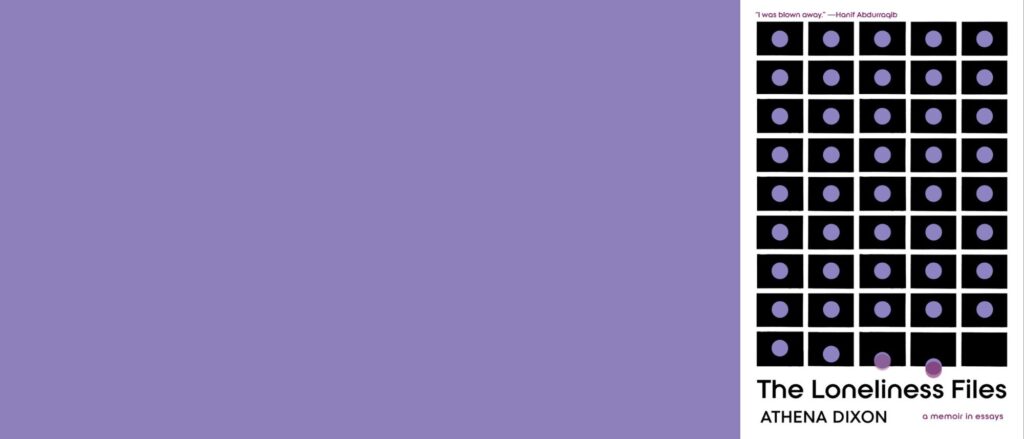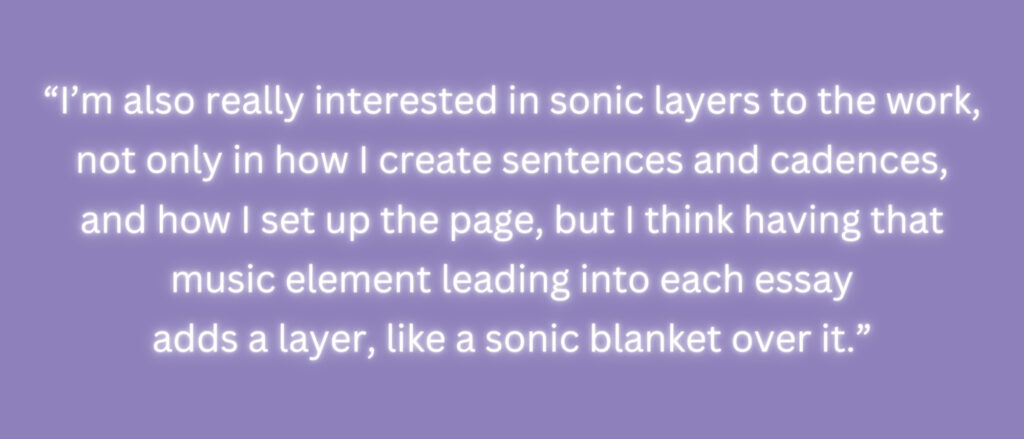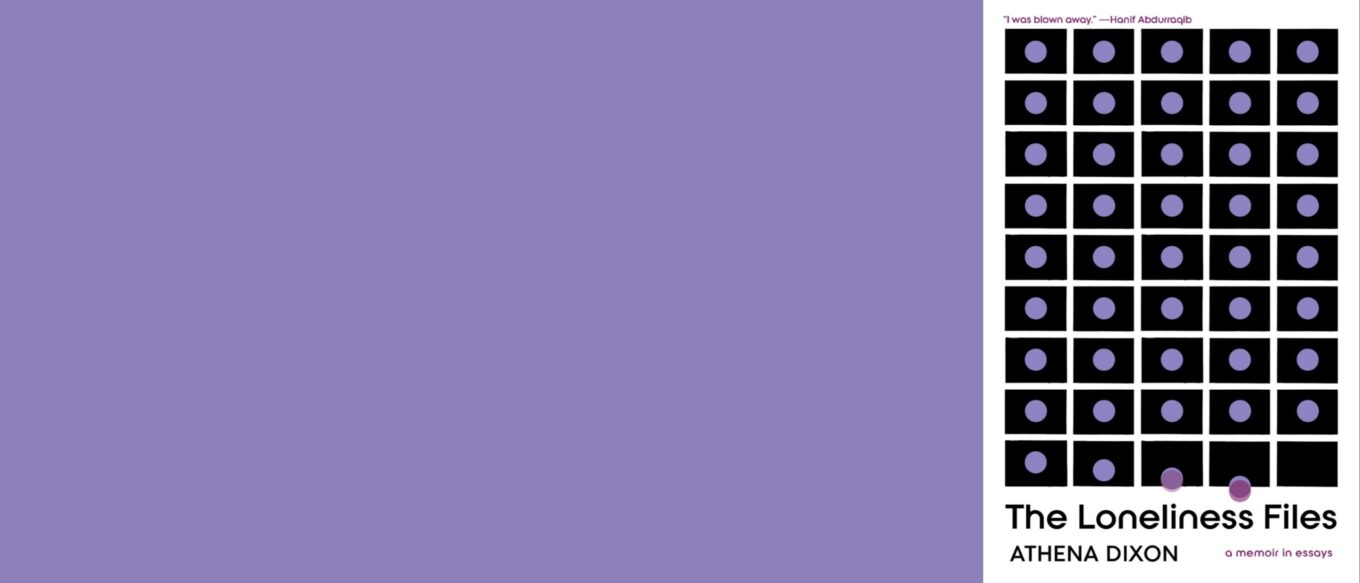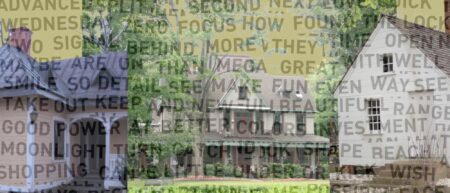The Loneliness Files (Tin House 2023) by Athena Dixon is a quiet meditation on loneliness in a hyper-connected world. She contemplates what leads to loneliness, what it means to be alone versus lonely, and explores the comfort in being alone juxtaposed with the desire to be seen. Dixon sifts through the silt of memories uncovering glittering bits of the ordinary, those day-to-day moments and choices, that connect us if we let them.
Just before her book release, Dixon and I met up via Zoom—her from Philadelphia, me from Baltimore—for a wide-ranging conversation. We discussed choosing book covers, her decision not to name COVID-19 until almost the end of the book despite its presence throughout, finding both community and loneliness in social media, how putting on a green dress and red lipstick can mean showing up for yourself, and how the algorithm inspired her book.
What follows is an edited and condensed version of our conversation.
Cija Jefferson: In the first essay, “Say You Will Remember Me,” we meet you “On the cusp of 2021, in a green dress and red lipstick…” You are home alone, overwhelmed by the losses of 2020 from the literal deaths to dreams deferred. On the heels of that scene, you introduce us to Joyce Carol Vincent, a woman in London who died sometime before Christmas in 2003 but wasn’t found until January 2006. When I read that I felt like, ok, we’re getting right into it, let’s go! Why did you begin here?
Athena Dixon: The book itself came to be based on me stumbling across her story, and being alone in my apartment during the time of the Covid lockdowns; going from being in an office five days a week, and hearing so much noise and conversation around me, to just being a singular person in an apartment. I started playing video game walkthroughs, specifically horror, because the voices started and stopped here and there, and it sounded like real conversation. Because of the algorithm that exists in everything that we do, I started getting recommendations on YouTube for mysterious disappearances and deaths and true crime podcasts.
The first time I came across Vincent’s story was on one of those videos. I was immediately obsessed because this was a fear that I never really looked into much. But I was like, that’s me: I’m behind this triple-locked door, hundreds of miles from my family. It was the first time I was like, wow, I kind of made a whole bunch of decisions, and some decisions were made for me, to put me in this place where I could leave just like her.
I got really obsessed with researching Vincent and finding whatever little information I could about her, and again, the algorithm kept leading me to these stories of these people. I just started writing about how isolation exists in my life and how loneliness manifests, and that’s how the book came to be.
CJ: Early in the book you say, “My loneliness is not groundbreaking…I don’t expect it to be important to anyone other than myself, but I write about it anyway.” This feels like an act of defiance, and it sets the tone. This is a powerful statement and the opposite of shrinking; I’m thinking of your first book, The Incredible Shrinking Woman. You are claiming space for yourself. Was this intentional?
AD: I’m not necessarily sure, especially because I’ve started to think of the difference between the two books. The first book was very selfish. That book was very much rooted in me feeling voiceless and invisible, and I did not care if there was a connection to the larger world or a larger community. I just felt like I had to say what I needed to say, because I felt like nobody had ever listened to me before. In The Loneliness Files, I was much more conscious of trying to find a greater connection to the world, and then pushing past my own fears of doing that.
One of my biggest stumbling blocks early on was that I was worried I was taking myself too far out of the book with the research. That’s why you see the book progress as it goes from the macro down to the micro. At the very beginning of this book, I had to make sure that I was putting myself in it, and pushing through my feelings of imposter syndrome, and my feelings that nobody cares, or everybody’s lonely. There was a very conscious effort at the beginning of the book to make sure my voice and my experience showed up.

CJ: I was struck by your meditation on sonder— the ways in which we can be so focused on our own lives, as if they are more important than anyone else’s. You insert hope and possibility when you say, “I would like to think that in the sonder of our individual lives there are always quick glances beyond our own veils. It feels so much better to think of the world this way—sputtering connections that can sometimes charge to life and light our ways back to each other.” This is what memoir does for me, it breaks that sonder, and connects me to others. Is this a concept you’ve been mulling over for a while or was it something that came up from your research?
AD: Funny enough the word sonder was something I had never really heard of before, but the concept of it was something that me and my dad have talked about for years. It wasn’t until John Koenig’s book [The Dictionary of Obscure Sorrows] came out, and I came across the original Tumblr post that had his definition for it that I realized this is something that me and my father had talked about a lot. We’ve had this conversation over the past couple of years, this idea of you never know what’s going on in somebody’s life, you’re just passing each other in the street, and if you’re lucky you make the briefest connection with that person.
When I came across sonder, I was like this is it, especially in the moment that my book was written. We now are forced to have these sputtering connections because we can’t physically be together. We can’t exist in the same social ways that we did before, like, how are we paying attention to each other’s lives now? For me it was very much passing people, and only being able to see their eyes through a mask. That’s the connection, that briefest human connection, and you don’t know where they’re going after they leave you. It was a concept always kind of rolling around in my head and in the conversations with my father, but it wasn’t until I read John Koenig’s actual definition that it fully solidified that it was something that I really wanted to explore.
CJ: You don’t name the pandemic until the final section of the book, but contextually it’s present and accounted for throughout; this feels intentional. Did you decide from the beginning not to say pandemic right away or is this a choice that came later?
AD: I made a conscious decision not to have to name it unless I was talking about something in the book that was specific, like the death of my aunt since that’s how she passed away. I also realized I could not write a book during the span of 2020 to 2022, when all the essays were written, and not reference the reasons why I was alone. So my decision was to make Covid very much a lens that the book exists through, but not the primary vehicle.
You have to be true to the time period that you’re writing. You have to decide where to focus your energy in an essay or memoir, or in music, TV, or art. But when you lean too deeply into a particular cultural touchstone too soon, it dates what you’re working on. How do I talk about what was very much the biggest thing in the entirety of everybody’s lives during the time the book was written, but also not make it a Covid book–because it’s not?
CJ: The Loneliness Files is book-ended by New Year’s Eve 2021 and 2022. I love how you use the holiday as an entry and exit point for this collection. Giving us a sense of time, although your memories in-between are not linear. I’m curious to know what made you begin and end here.
AD: I think part of it is because the opening memory of me being partially drunk and dressed up in my living room was one of my most vivid memories of those first nine months of Covid lockdowns. I think that was the first moment I was like, I’m truly, truly alone. I could hear people and fireworks here and there from some neighbors who were outside, but I was really by myself.
It was the first time, too, that I felt the weight of how long it could go on. We were so optimistic: oh, the numbers are coming down, it’s getting better, and then, as we’re heading into 2021, there’s already this expectation that the New Year fixes all, right? And I was like, no, tomorrow’s going to be tomorrow, and more people are going to die, and we’re going to be locked away from each other. And I don’t know when I’ll get to see my family. That was going to be my anchor point.
At the end I decided that I needed a vessel to contain the story, because I knew that the narrative wasn’t going to be chronological. The book started off in chronological order, and it didn’t have the same kind of impact. Without chronology, I needed some kind of vessel to hold the story. The best vessel for me is to give a timeline that’s going to give a clean entry and exit point.
We know at the beginning I have all this fear, and there’s not that much hope, and then at the end there’s still not a lot of hope, but there’s more hope. I hope that between those two points I was able to show that there’s been some kind of movement of emotion, there’s been some kind of resignation that the life of the prior year can be no more. Now we’re headed into a new year, now it’s up to me to change instead of assuming the flip of the calendar is going to make it better. The main thing was an organizational vessel to put the story in so it wouldn’t be too unwieldy.

CJ: That “movement of emotion” reminds me of a passage from bell hooks’ book, remembered rapture: the writer at work, “The longing to tell one’s story and the process of telling is symbolically a gesture of longing to recover the past in such a way that one experiences both a sense of reunion and a sense of release” (84). That seems to be exactly what you’re saying writing this book did for you.
AD: Yes!
CJ: That just resonated. What you said tied exactly into writing memoir, and this particular story.
Moving forward, you explore the nuance of social media and how it affects our ways of being and seeing ourselves. You say, “The algorithm knows me. They’ve taken the digital scraps of me and pieced together a person who doesn’t quite exist, but is exactly who I am.” This is most certainly universal. I literally laughed out loud when you said, “It knows my insecurities and sends me missives about face waxing and weight loss and dating sites.” Can you expand on this?
AD: You know, I think the reason why I wanted to include that particular vein, especially how it shows up in “In Service of the Algorithm,” is because I don’t think a lot of times people think about digital loneliness because we call it social media. Right? We call it a community.
I’m going to sound old and dated, but I came onto Yahoo Chocolate City chat rooms back in the late nineties, that felt like a community, and it felt like we were building some kind of thing. Technology was completely different so you had to get a scanner to get pictures up and stuff, but it felt like people were really just getting to know you as a person.
Fast forward twenty plus years later and now everything is highly curated. It’s highlight reels, it’s content creation. I don’t think people talk a lot about digital isolation, whether it be that you don’t feel like what you’re accomplishing is good enough because everybody’s life is magical according to social media, or how lonely it is when those communities that you built through social media disappear. In the fandom essay [“I Was in Love with Jake Sisko”], I write about being iced out of an online community; I felt like the rug was pulled out from under me because of my age.
I wanted to make sure that got talked about because I think that we collectively, and me included, forget that social media is sometimes just a title–not an actual act. I think in this day and age you actively have to work toward building community online because you could be online and be completely alone despite how many followers you have, despite how many likes or reblogs you get, you could just be alone. So I wanted to, even if I inadvertently kind of put it in there, talk about the organic nature of social media versus what we currently have.
CJ: Let’s talk about the cover. I feel like yours perfectly encapsulates the idea of everything seemingly being in order, then the slow slip off the grid until you disappear. How much of a part did you play in this process?
AD: I was pretty hands on with the cover. I had to give them things that I liked and disliked. I gave them an email full of sample covers, but my main directive was I wanted something that looked very 1960s Vintage Penguin book cover, especially the English ones because I’m obsessed with them. There was only one last-minute change that we made, but this is the first cover out of the gate.
Everybody I’ve talked to about the design process of it, and family and friends who saw the cover before it came out, had this kind of 50/50 split of what they thought the book was about. For me I thought it was people coming into line with what society expects you to be, coming into being isolated, coming into the loneliness. Then my dad very much was like, no, I think it’s people falling out of the loneliness and waking up and realizing that they don’t have to be in these little individual boxes. I really liked that the cover was so open for interpretation.
CJ: I’m into covers, but that’s separate from the writing, and maybe you weigh in a little bit, but I love that you really had a thought process behind it.
AD: Yeah, this is the second time I’ve gotten to really be super hands on because it was the same thing for the Incredible Shrinking Woman. The artist who did that cover was a friend in one of my writing groups and I was like, I want her art on the cover. I think that’s really indicative of being with a smaller press or an indie press; you have the opportunity to be so much more hands on with the choices and the decisions for your cover.
CJ: Each section of the book begins with three songs of ‘recommended listening.’ I was hyped and promptly made a playlist. How did you decide what songs to use and how does music inform your writing, if it informs your writing?
AD: Absolutely. It does. I say all the time that the best nonessential money I spend every month is my Spotify family premium plan because I listen to it all day, and I create playlists for everything that I’m writing. So there’s like a four or five hour playlist for the book. There’s one for The Incredible Shrinking Woman. There’s one for the book I’m currently writing. I create playlists for everything, and that’s how I come to the table.
I don’t listen to music while I’m writing, but before I write I’m listening. Some days it’s the whole playlist, some days it’s individual songs on repeat.
Originally, each essay had a song and then each essay had song lyrics. But even if you credit the artist, you have to have the rights to any lyrics you’re going to put in a book. So I removed the lyrics and went back to the playlist to say which songs I thought define each section, and that’s how those three songs came to be.
I’m also really interested in sonic layers in the work, not only in how I create sentences and cadences, and how I set up the page, but I think having that music element leading into each essay adds a layer, like a sonic blanket over it. I’m not trying to hand hold the readers, but I want you to be in a certain space when you come in. I don’t want you listening to like club music, and then you’re about to read about the deprivation tank. I want you to have a clean table when you come in.
CJ: Throughout the collection there is a duality you explore between who you are and who you want to be. In the last section of the book this manifests into who you are in your hometown of Alliance, Ohio around your family versus who you are in your “adopted home” of Philly. Why was it important to conclude the book with a reflection on home?
AD: I mentioned a little bit earlier about moving from the macro to the micro. I think that by the time I got to the last essays in the book, through all the worldly things that had gotten me to where I was, and got me to Philly isolated in the apartment alone, I started having this real like crisis, mainly spurned by death, because there was so much death that happened in 2021 into 2022 for me. There were like nine deaths back-to-back, and it really set me on this path of, what is home for me?
Home is Philadelphia because I’ve built a life here, and I have friends, and I’ve proven what I needed to prove by moving here. But I needed to reflect on what is actually my home, and what do I give up by not going back there? What do I give up by leaving Philadelphia, and what’s the best course forward? So part of it was nostalgia, part of it was guilt about being away for so long and being away during times when I should have been there. Those kind of gel together in this meditation on who I want to be versus who I am. I think that the book ends with no resolution because I haven’t made the decision yet. I wanted it to be out of my head and out of my heart enough where I could kind of lay everything on the table and look at it, and make a decision on the best path forward.
CJ: I want to go back to the beginning. That image of you in the green dress with the red lipstick crying and dancing was visceral for me. You and I have talked about the power of a red lip, and how it can be like armor. For me this knowledge makes that first chapter even deeper because you are showing up, and it’s something I thought about at the end because we talked about how some readers feel the book is sad, and to me there is hope there. I came back to that because you are trying, and really isn’t that all we can ever ask of ourselves?
AD: I think, too, that even if a person doesn’t connect with the book or something doesn’t resonate for them, I like to think that at some point the reason why they are having a reaction like sadness is because it is opening a conversation for them.
It might take them a year or two, or months, or however long, or they may never get there, but it’s opening something in their head where there’s some kind of spark like, why do I have this reaction to this, why do I feel this way, what can I do with those feelings? And if that’s where I leave people at the end with their own questions and their own kind of path to explore, then I did my job.
CJ: When you ended the book, you also showed up with hope and possibility still there.
It’s not beating you over the head, it’s not that kind of story. This, to me, feels quiet and internal, yet you tie it into the bigger world with these news stories about different women who died alone, and the pop-cultural references you cite.
AD: I’m glad you said that it was quiet, because that is like one of the most internal things that I talk about in my brain when I’m thinking about my writing, is that my whole goal is to write quietly.
I think sometimes the stories that get the most attention or the most engagement are ones that are boisterous and loud. I think there’s this segment of people in the world who feel these very big things, but they feel them quietly. When I write in “Auld Lang Syne” at the end about how sometimes grief is quiet, those are the kinds of things I write towards. I’m glad that you said that because that’s always my goal.
I used to joke that when I wrote poetry, I wanted to write the background music of life, like the stories that exist in the everyday that don’t get the shine. That is always the goal, to lay the world out quietly and let people come to it, however they come to it. Then, to allow myself to have a voice, too, ’cause I don’t think my voice is loud, and I don’t think it ever will be loud; allowing myself the grace to speak everything I need to speak and show up in the way that I need to show up, just in a lot more muted tones.
–
Athena Dixon is a poet, essayist, and editor. She is the author of The Loneliness Files, The Incredible Shrinking Woman, and No God In This Room. Her work is included in the anthology The BreakBeat Poets Vol.2: Black Girl Magic and her craft work appears in Getting to the Truth: The Craft and Practice of Creative Nonfiction. Athena is an alumna of VONA, Callaloo, and Tin House and has received a prose fellowship from The Martha’s Vineyard Institute of Creative Writing. Born and raised in Northeast Ohio, Athena now resides in Philadelphia.
Cija (pronounced Key-a) Jefferson is the author of Sonic Memories/and other essays. She earned her MFA in Creative Writing & Publishing Arts from University of Baltimore, and her BA from Sarah Lawrence College. Her writing has been featured in multiple publications some of which include Split Lip Magazine, palatePALETTE, and Sisters from AARP. She is a 2023 Baldwin for the Arts fellow.



